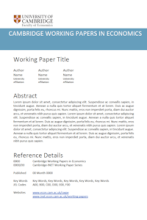Social, economic and infrastructure networks are an important feature of an economy. A distinctive feature of these networks is heterogeneity in connections.
This is reflected in hubs, dominant plat- forms, superstars and key players. Classical models of networks suggest that hub-spoke networks maximize social surplus and are consistent with individual incentives (Bala and Goyal, 2000; Hen- dricks, Piccione and Tan 1999; Jackson and Wolinsky 1996). However, in experiments with human subjects such structures arise rarely. The main explanation provided by the existing literature is that subjects disapprove of the inequality inherent in such networks (Goyal 2007; Choi, Gallo and Kariv, 2016). These findings fly against the empirical prominence of such networks and motivate a closer examination of this tension between efficiency and fairness.
The novelty in the proposed research lies in the scale of the experiments: we will study how group size affects the emergence and stability of very unequal networks. Existing work has focused on small groups – typically around thirty subjects or less (see, e.g., Kearns et al, 2009; Kearns et al, 2012; Charness et al, 2014; Riedl et al, 2016). Building on programming and experimental expertise we have developed in an on-going Horizon 2020 Research Grant, IBSEN, we propose to run experiments with groups involving up to a hundred subjects interacting together in real time. To the best of our knowledge, these would be the first such large scale laboratory experiments on networks.
The possible impact of scale is brought out in an on-going project, ‘Competing to be a Star’ (joint with Syngjoo Choi and Fred Moisan). In this project, we carry out experiments on a model of linking and information purchase. The theoretical model is taken from Galeotti and Goyal (2010) where players can both purchase information and form links with others to access their information. It predicts that the equilibrium network has a core-periphery structure, the size of the core is small in large groups, and the core members do all the information purchase, while the spokes do no purchase. In other words, there obtains a ‘law of the few’.
Recent experimental work by van Leeuwen et al (2015) and Goyal et al (2017) showed that the predictions on effort specialization and on the network structure are typically violated in experiments with groups of size 4 and 8.1 By contrast, in our on-going project, ‘Competing to be a Star’, we conduct experiments with 50 subjects and observe great specialization in effort and also see the emergence of hub-spoke networks. Specifically, we find evidence for a 80-20 rule in efforts (the bottom eighty percent of the group purchases only twenty percent of all information) and a 80-20 rule in the distribution of connections (the bottom eighty percent of the group receives much less than ten percent of the links). This specialization in purchase and this network structure does not arise in the experiments with small groups of 4 and 8. In groups of 4, for instance, the bottom 80% of the population purchases close to 50% of the information and receive almost 40% of all links. These findings suggest that the scale of the group has large and economically significant effects on individual behavior. We note that in the treatments we ran there were only modest payoff differences between hubs and spokes. The goal of the proposed research is to build on our on-going work to and to examine the role of scale in shaping structure and behavior in a context where efficiency entails significant inequality.
Fehr and Schmidt (1999) and Bolton and Ockenfels (2000) have shown that people are sensitive to inequities in their favor as well as against them. In the context of networks, studies by Goeree et al (2009) and Falk and Kosfeld (2014) have revealed significant effects of such inequality aversion in network formation scenarios: a star network naturally emerges in the lab only in the absence of payoff inequality between the hub and the spokes. These studies involve small groups of 4 or 6 players only. It therefore remains uncertain whether such results would extend to larger groups.
Scale may attenuate the negative effect of inequality. For instance, the inequity aversion model by Fehr and Schmidt (1999) considers the average payoff difference between the self and every other individuals. Given a fixed sensitivity to inequality (i.e., stable inequity aversion parameters in the utility function), increasing the group size while maintaining the number of rich individuals constant (hub in a star network) decreases the impact of those rich people on others’ inequality preferences. On the other hand, note that increasing the group size is predicted to increase pressure on the rich individuals’ inequality preferences (as it increases the average payoff difference with others). However, Fehr and Schmidt (1999) argue that people are not as sensitive to such advantageous inequalities as to disadvantageous inequalities. This motivates the proposed experimental exploration of the relation between efficiency and inequality, as we vary the scale of groups.
1 Rong and Houser (2015) study a similar game and explore the role of restrictions on decision rules and investments in facilitating the emergence of stars.
Large Scale Experiments on Networks: A New Platform with Applications
Large Scale Experiments on Networks: A New Platform with Applications, Syngjoo Choi, Sanjeev Goyal and Frédéric Moisan, Cambridge Working Papers in Economics (2020)
This paper presents a new platform for large scale networks experiments in continuous time. The versatility of the platform is illustrated through three experiments: a game of linking, a linking game with public goods, and a linking game with trading and intermediation. Group size ranges from 8 to 100 subjects. These experiments reveal that subjects create sparse networks that are almost always highly efficient. In some experiments the networks are centralized and unequal, while in others they are dispersed and equal. These network structures are in line with theoretical predictions, suggesting that continuous time asynchronous choice facilitates a good match between experimental outcomes and theory. The size of the group has powerful effects on individual investments in linking and effort, on network structure, and on the nature of payoff inequality. Researchers should therefore exercise caution in drawing inferences about behaviour in large scale networks based on data from small group experiments.


